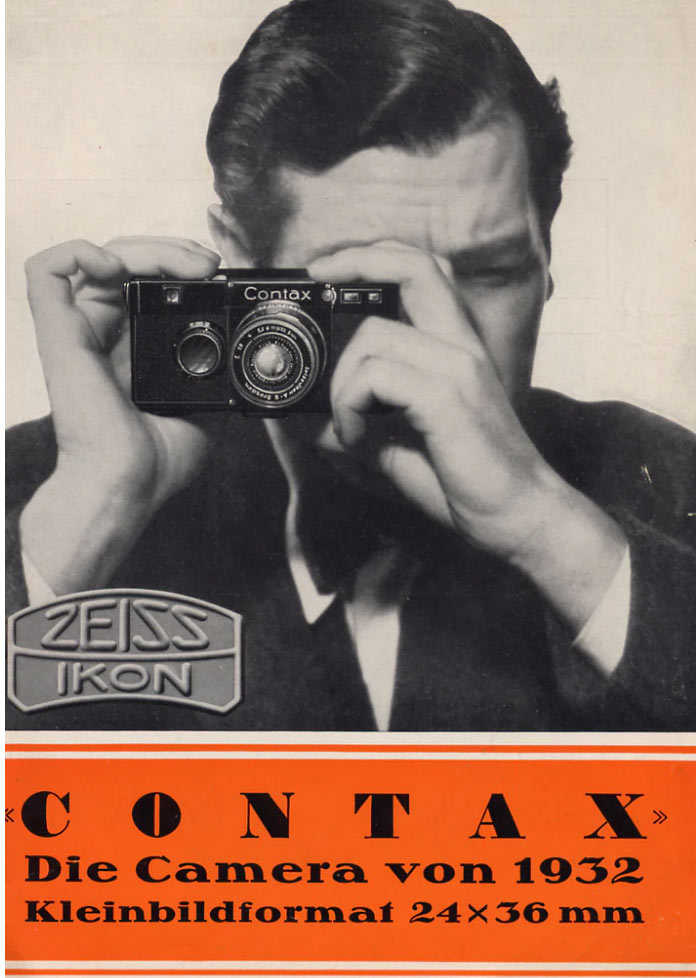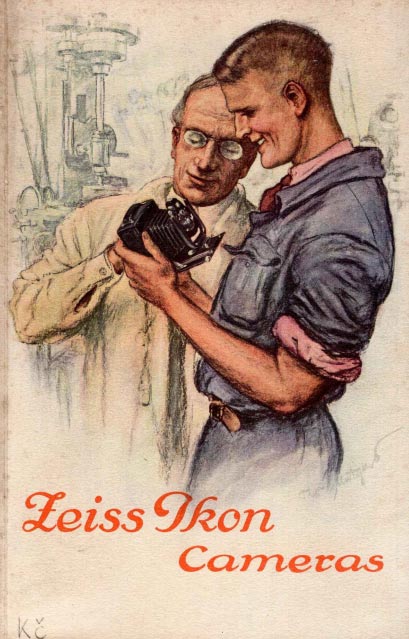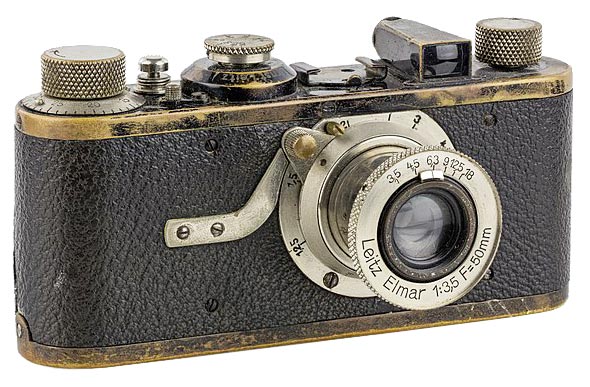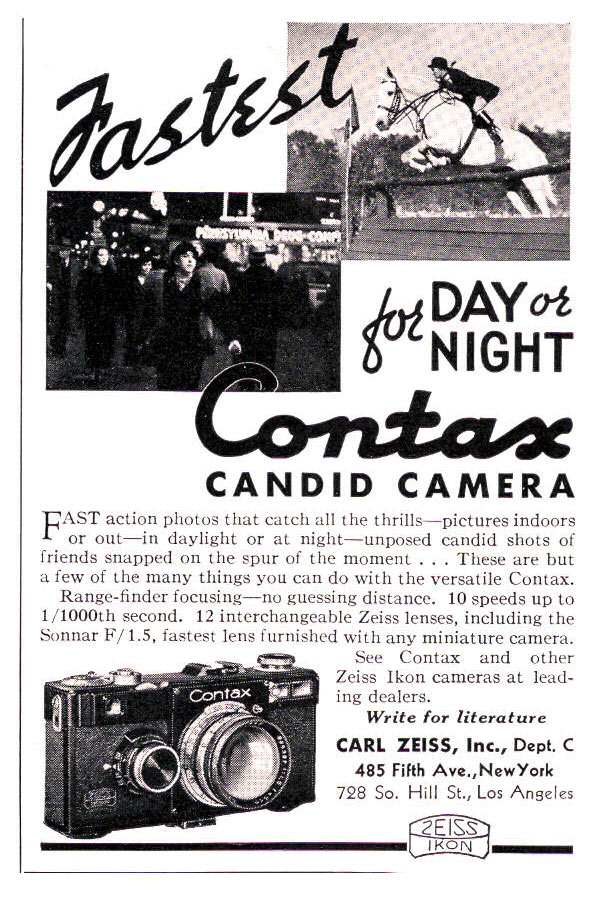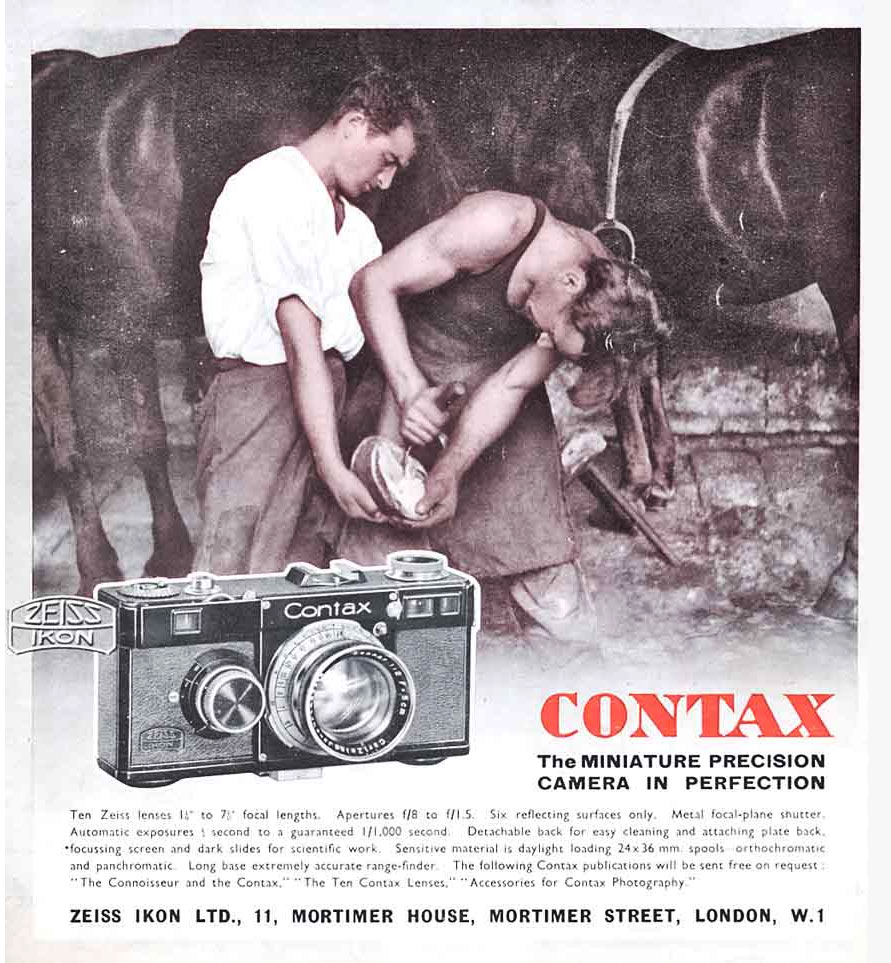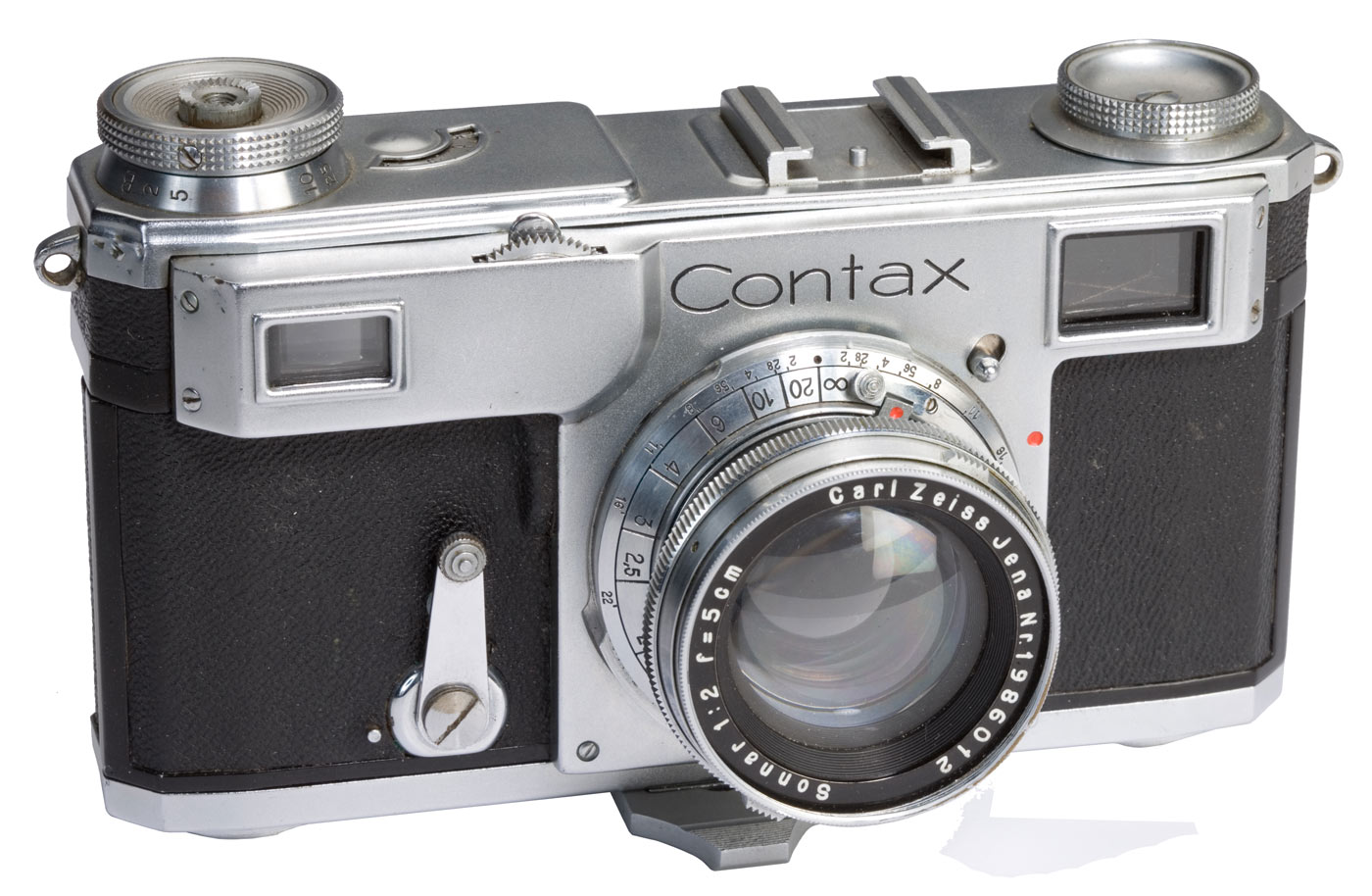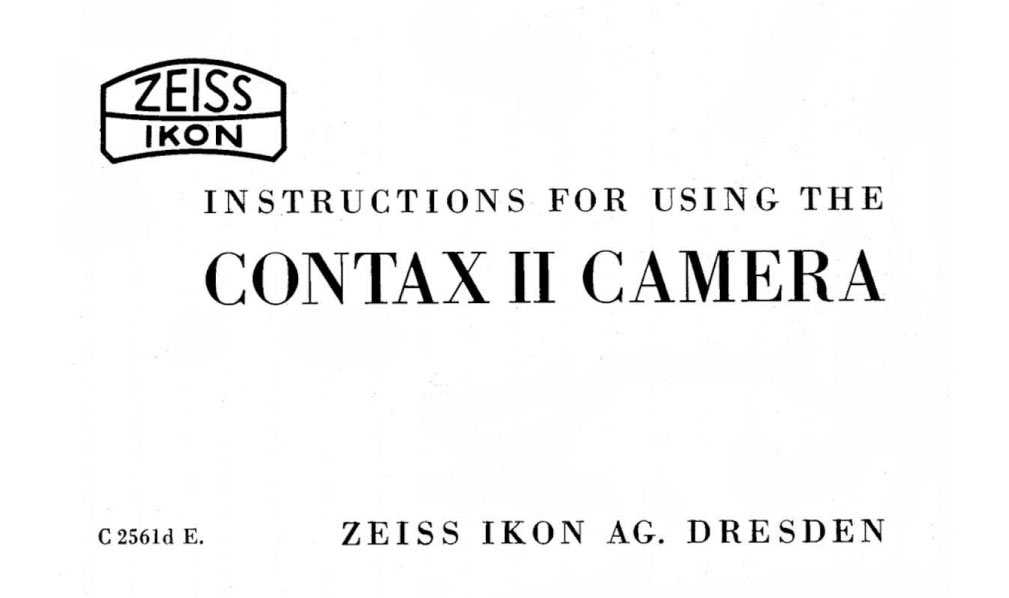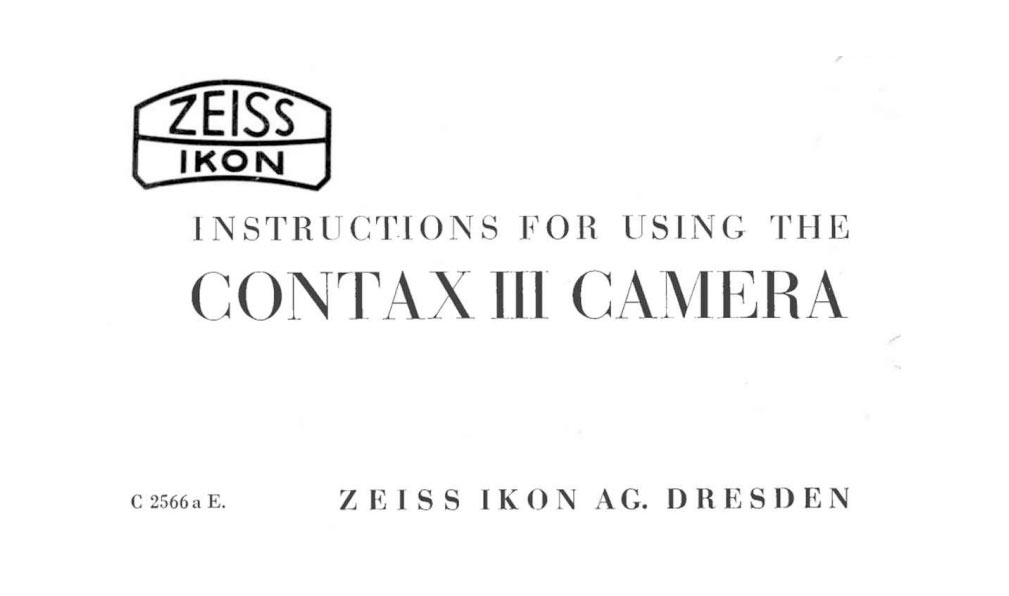Zeiss Ikon et al
The Contax Cameras
Designed to give Leica a Run
It is Russia’s fault, really. I bought a Kiev 4AM without knowing anything about it but I wanted to do something to contribute to the Ukranian economy. I wanted to make a small gesture of support so I contacted a camera store in the Ukraine and ordered a camera. And I began to read about the Kiev cameras, which led me to the Contax cameras and the history of the Zeiss cameras and lenses generally..
I so enjoyed my Kiev 4AM that I ordered a Kiev 4A from the same shop. This second camera had a shutter problem so I bought a third Kiev camera with shutter problems to take a part and study. And while I was at it I bought a pre-war Contax II that also had shutter problems. And so, without thinking ahead, I ended up up to my hips in Contax/Kiev cameras.
Since then I have acquired further Kiev camera models at a local camera show and I have been digging into the inner workings of these cameras. I have bought silk ribbon to repair shutter curtains, I have taken two of these cameras apart
to understand the inner mechanisms so I can repair them. It has been a compulsive rush!
But still, I am a Canon collector above all. But this diverson has been so much fun! It occurs to me that I should be writing down what I am learning and doing, which brings us to this page.
Carl Zeiss
A good place to start is with Carl Zeiss as his company forms such a large part of our story. As our interest is in the cameras, what follows is necessarily only an outline. Zeiss was born in September of 1816 to a respectable upper class family that was able to educate its children well. He showed an early aptitude in technical studies at the University in Wiemar. As a result he took up as an apprentice to become a master machinist. He moved to Jena at Easter in 1834 and began a four year apprenticeship program while at the same time taking lectures at the local university.
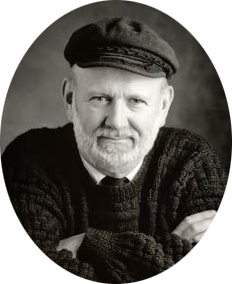
He finished his apprentiship in 1838 and he bagan working in various shops as a journeyman machinist and pursuing his studies taking courses at various universities. in 1846 he finally applied for a permit to set up his own precision machining and optical shop in Jena. He opened a small establishment in Jena doing repairs on fine machinery, selling optical supplies and finally manufacturing simple microscopes.
Zeiss was a good organizer and he recruited talented people to work for him. And all the while he studied and researched the construction of superior microscope optics. By 1872 he was offering microscopes as good as any then available in the day and by organization and increased efficiency in production his prices were extremely attractive. In 1896 the company had grown to 60 employees and that year saw the production of their 3000th microscope.
One of the obstacles to better lenses was the problem of obtaining consistent supplies of optical glass. Zeiss created a glass foundry in Jena to supply the glass he needed which gave his company a further competitive edge.
Zeiss was not known as a great optician but he was an organizer and had the ability to gather talented people around him. He believed in research and in producing the finest of equipment. He died in December of 1888. On his death the company was incorporated as Carl-Zeiss Stiftung and continued to do business. By the First World War it was one of the largest producers of microscope and photographic lenses and cameras in Germany.
Zeiss Ikon
The First World War set Germany back on its heels economically and there was much social chaos. It was not a great time to be in business. However, German cameras were a bright spot as they were a product that could be readily exported and they were in great demand. However, the market was not large and competition amongst the largest of the camera and lens manufacturers prevented any of them from becoming dominant. Merger seemed the best option.
In 1926 four of Germany’s largest camera manufacturers, Contessa-Nettel of Stuttgrat, Emermann Werke of Dresden, Goerz of Berlin and Ica of Dresden merged into Zeiss Ikon. Zeiss was very much a prime mover of this amalgamation and provided much needed capital for the new firm. However, it seems that Zeiss saw the new company as a customer for its line of very famous lenses and the firms that joined the new venture largely gave up their own manufacture of photogrphic lenses.
In the result the new company ended up with several factories and a wide range of cameras and models. Looking at the two catalogues on the left you will see a dazzling array of equipment being offered. But the market was changing.
In the 20’s photography was not easy. The films were large and the cameras were larger. To go for a walk and snap a few pictures or go to a family picnic and snap pictures of the kids was a challenge. That’s why there are so few amateur photographs from that time around today.
But there was a man in Germany who was about to change all of that and make photography a universal activity. That man was Oskar Barnack.
Leitz and Kodak
Oskar Barnack was an engineer working in the motion picture division of Leitz before World War I. He was an amateur photographer and loved to spend time walking in the countryside around the town of Wetzlar where the Leitz factory was located. But he found the cameras available to be too large to carry easily and the number of pictures they could take was limited . He wanted something he could carry easily that would take more pictures.
At work he was very familiar with 35mm film and he had manufacturing equipment available to him so he decided to create his own 35mm camera.
When he had a working camera he took it to Leitz suggesting they produce it. However the War intervened and the project was shelved for several years. It was not
until 1925 that Leitz finally brought out the Leitz Camera, the Leica.
It was viewed as a marvel at the time in view of what other cameras were like and it was very well received. But it had its problems. Because the film format was new those very early cameras required the user to cut and roll their own film for the camera. And it had no rangefinder so focus was by the scale on the lens. And of course, prints required the use of an enlarger. But, given all of that, it was popular with a select few who appreciated the size and convenience as well as the quality of the images.
It was the decade of the 1930’s that saw 35mm photography become a mass phenomenom. In 1932 Leica introduced the Leica II which had a built in rangefinder which allowed accurate focus but maintained the small size of the camera.
It was Kodak that introduced the biggest and most influential innovation: the 135 film cassette. This seemingly minor development, introduced in 1934 made it possible to buy film in pre-cut lengths in light tight cartridges that could be loaded in daylight. It was truly revolutionary and yet such a simple thing! But it set 35mm photography on the path to dominance.
The Contax Camera
The success of the Leica camera was not lost on the people at Zeiss Ikon. To their credit they saw the potential of the new camera with the small film format. Compared to what was available at the time it was revolutionary. The decision was made to get into this new market with a camera that outperformed the Leica.
It took several years of work but, in 1932, Zeiss Ikon introduced the Contax I. The name was arrived at after input from company employees. In many ways this camera was superior to the Leica. However, the camera did not stand up well in use.
It did have a superior rangefinder and the lens mount was a bayonet type. The back was removable for easy loading, the shutter was metal and the lenses from Zeiss were of excellent quality. And there was available a large range of accessories.
Although the camera was boxy, when it worked it was the equal of the Leica. It is too bad that it did not do well in service. Many had to be returned to the factory for adjustment or repair and it developed a bad reputation.
The Contax I was manufactured from 1932 to 1936 when it was replaced by the improved Contax II. Serial numbers began with a letter which denoted the year of manufacture. A second letter would be added if the camera was returned to the factory for repair.
Ica, one of the companies folded into Zeiss Ikon, before the merger developed a serial number system based on a letter followed by 5 numerals. After 1926 Zeiss Ikon continued with this system. From this chart below one can determine the year of manufacture of the Contax I.
| T | 1931/32 |
| U | 1932/33 |
| V | 1933/34 |
| X | 1935 |
| Y | 1934/35 |
| Z | 1935/36 |
| A | 1936 |
As production proceeded the weaknesses in the design were obvious and fixes and upgrades were introduced into the manufacturing of the cameras but the name did not change. By the end of production in 1936 the camera, internally, was much improved and much more reliable. Unfortunately, the problems experienced with the camera gave it a bad name.
.
The Contax II
Changes were made to the Contax I during 1932 thru 1936 but the exterior remained the same and the name did not change. In 1936 Zeiss Ikon decided it was time for an improved camera that addressed the issues of the first model and incorporated a suite of new features: the Contax II.
The new camera was produced in chrome and black leather. The film advance was moved to the top of the camera and the viewfinder and rangefinder were combined into the same window: the first camera with such a combined VF/RF. Internally it kept the same vertical shutter, although substantially improved, and film loading was easy with the removable back. The top shutter speed was increased to 1250th second. It is said this was chosen just so they could say it was faster than the Leica.
The early cameras had the Serial Number on the bottom of the body and inside the camera back. Later cameras
The Contax III
A few months after release of the Contax II in 1936 Zeiss Ikon released the Contax III. This was the same camera with the addition of a light meter on the top deck. This was notable for a couple of reasons.
Light meters had been in development for years by this time but they were bulky and read out in lumens and other units that were not of much use to photographers. And most were decidedly not portable. Then, in the early 1930’s, Edward Weston applied for his first US patent for a portable exposure meter which was granted in 1935. So Zeiss Ikon was on the cutting edge of technology with this camera. It was one of the first cameras with a built in exposure meters and certainly the first 35mm camera with one.
Considering how primitive light meters of this period were, this one was a real miracle. The meter was not coupled to the iris or shutter dial but it did read out in speeds and f/stops.
Using the dials on the top deck left side, right side in the picture on the left, you could adjust the meter needle to align with a diamond on the meter scale. If you did this then the dials showed speed and f/stop combinations that would give correct exposure. You then had to set these readings on the camera controls. Have a look in the
manual, located above, to read the operating details. For the time period, it is an incredibly smooth effective arrangement.
The Contax II and III were manufactured from 1936 into about 1942 when production in the Ica Dresden factory was devoted almost exclusively to war output. Production ended with O65500 in 1943.
The year of manufacture can be determined from this chart:
| C | 10001-15000 1936 |
| C | 87001-90000 1937 |
| D | 1937 |
| E | 1937 |
| F | 41001-46000 1937 |
| F | 72401-77400 1938 |
| G | 1938 |
| J | 1938/39 |
| K | 1939 |
| L | 1939 |
| M | 1940/41 |
| N | 1941/43 |
| O | 1943 |
And then it got Complicated …….
Up until the War, the Contax cameras were made in the Ica factory in Dresden and Carl Zeiss made the standard Sonnar lenses for them at their plant in Jena. During the war the Dresden factory was completely destroyed along with tools, equipment, plans and drawings. Almost everything was gone. In Jena, on the other hand, in spite of bombing attacks on the Zeiss factory, it survived the war relatively intact.
The Allied powers, the United States, England and Russia, met at Potsdam in Germany in July of 1945 to negotiate how Germany was to be dealt with after the war. The Yalta Conference in the previous February had already determined that no war reparations were to be paid in cash but in industrial assets, tools, machinery, railways, ships, patents and research data, and a certain amount of forced labour. This was further elaborated at Potsdam. Germany was to be divided into four zones administered by the four powers, France, England, the USA and the Soviet Union. Berlin was to be similarly divided. The dismantlement of German industry, so she could never again wage war, was to be limited by 2 factors: the German standard of living was never to be less than that of the average of other European nations, and Germany was to be left enough capacity to pay for essential imports so that she could be self sufficient. Distribution was to be controlled by the “Inter-Allied Reparations Agency” established in 1945.
Unfortunately, these arrangements worked for a little while but friction quickly developed between the Western allies and the USSR and things broke down somewhat. But it was agreed that war reparations that each nation received were to come from the zones controlled by that nation.
Exactly what happened to the Contax and Zeiss facilities immediately after the war, on my reading of Internet sources, seems to be confused. I have not found a definitve resource but we can get a rough outline of events. Although US forces first entered Dresden and Jena, by agreement amongst the Allies these areas were to fall within the Soviet Zone which eventually became East Germany. Apparently some resources from the Zeiss Jena factory were removed to Stuttgart to the Contessa plant.
The Soviets were aware of the Zeiss factories and the value of the camera industry. As a result they demanded the factories and rights to the Contax camera production. They insisted that the remaining engineers at Zeiss Ikon produced new drawings and machine tools for the production of Contax cameras. Carl Zeiss in Jena had a facility at Saalfeld near Jena and
a production facility was set up there. To test the equipment a limited production run of Contax cameras was made. These were called by collectors the “Jena Contax” cameras. The number made is not known but it could be a few hundred to a few thousand. In addition, parts for around 2000 cameras were made at Saalfeld until 1947. To do this German engineers and technicians were used and they undoubtedly trained Russian technicians at the same time.
The “Contax” Name
After the war German patents and trademarks offered little protection. The Soviet camera production used the “Contax” name with impunity. However, the Zeiss Ikon company in West Germany contested the use of the Contax name in court and sought copyright protection in the United States which was eventually granted in 1957. The Soviets understood that to export to the West they could not ignore this so they stopped using the Contax name.
There are fours kinds of Contax II and III post-war cameras. There are Contax cameras made from prewar parts by Zeiss workers. Some were made with a mix of prewar and post war parts. Remember, people were starving after the war and if they could make a camera and sell it to an occupation soldier they could take the money home and feed their family.
There are Contax cameras made by German technicians after the factory moved to Kiev. And there are completely counterfeit Contax cameras made in Kiev after the move. As German parts ran out, the cameras became more and more “Russian”.
And then there were the No Name Kiev cameras. These had no identifying name so that they could be imported into the West.
Finally, after the assembly lines were moved to Kiev, Ziess personnel in Jena continued to make Contax cameras but they had no shutters and so had to recreate them. These can be identified by small differences in the shutters. But that requires dissassembly and even then you have to know what you are looking for. These “clandestine” cameras continued to be made in Jena until after the production began in Kiev.
Post war Contax are difficult to identify as authentic. It is highly unlikely that any Contax camera marked with the word “Jena” or “Carl Zeiss Jena” are authentic. These are known to be counterfits. To truly identify them it is necessary to examine them internally and this is a subject for the advanced collector. Post war Contax cameras look like pre war cameras.
About this time lenses made in Jena added the word “Jena” to their name and “Carl Zeiss Jena” became a Soviet trademark.
However, as the Contax name brought higher prices on a camera, the name continued to be applied to their cameras, officially or unofficially, for a time. And to this day there is a brisque trade in unofficial conterfeits.
This is all very confusing and this is a very rough summary of what went on.
Still Working on This
This website is the work of R. Flynn Marr who is solely responsible for its contents which are subject to his claim of copyright. User Manuals, Brochures and Advertising Materials of Canon and other manufacturers available on this site are subject to the copyright claims and are the property of Canon and other manufacturers and they are offered here for personal use only.

